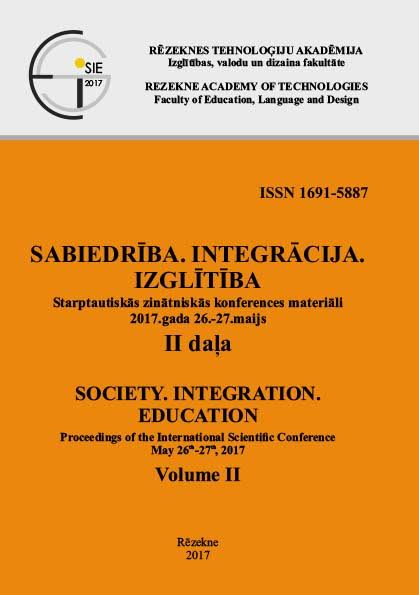STUDENT GRAPHICAL INFORMATION LITERACY IN MATHEMATICS AND SCIENCE
DOI:
https://doi.org/10.17770/sie2017vol2.2394Keywords:
student skills for work with graphic information, student performance in national testingAbstract
Among the most important 21st century skills that every student needs are the ability to work with information. The key for implementing competency based approach to learning will be related to how students' ability to apply skills acquired in, for example, mathematics can be transferred to other subject contexts. Newest OECD PISA results presented in 2016 show a recurring tendency that in Latvia there is a small number of students whose performance is in accordance to the 5th and 6th level of the framework. These two levels represent students' ability to apply deep thinking skills in new learning contexts. It is necessary to analyze the causes of this situation in order to identify opportunities for how to improve student performance. Accordingly, the research goal is to analyze how Latvian students manage to apply deep thinking skills in 9th grade national test assignments where they need to analyze graphic information in science and real life context. Additionally, the research aims to analyze the cognitive depth of science and mathematics assignments included in the national test as well as how the acquisition of these skills are planned in the learning content of educational regulations and learning materials.Downloads
References
Biggs, J.B., & Collis, K.F. (1982). Evaluating the Quality of Learning – the SOLO Taxonomy. New York: Academic Press.
France, I., Namsone, D., Čakāne, L., Dzērve, U., & Vilciņš, J. (2016). Teaching to Use in Science and mathematics Previously Acquired Skills. SOCIETY. INTEGRATION. EDUCATION. Proceedings of the International Scientific Conference, 2016. Volume II, (pp.51-65). Rezekne: Rezeknes Academy of Technologies.
Fullan, M. & Langworthy, M. (2014). A rich seam: How new pedagogies find deep learning.
Geske A., Grīnfelds A., Kangro A., & Kiselova R. (2016). Latvija OECD Starptautiskajā skolēnu novērtēšanas programmā 2015 – pirmie rezultāti un secinājumi. Latvijas universitāte, Rīga.
Harlen, W. (2010). Principles and big ideas of science education. Hatfield: ASE.
Hattie, J. (2012). Visible learning for teachers: Maximizing impact on learning. Routledge.
OECD (2016a). PISA 2015 Assessment and Analytical Framework: Science, Reading, Mathematical and Financial Literacy. OECD Publishing, Paris.
OECD (2016b). PISA 2015 Results (Volume I): Excellence and Equity in Education, PISA, OECD Publishing, Paris.
OECD (2016c). PISA 2015 Technical Report. Pieejams: https://www.oecd.org/pisa/data/PISA-2015-Technical-Report-Chapter-12-scaling.pdf
VISC. (2016). Diagnosticēsim dabaszinātņu mācību priekšmetu apguvi 9.klasē! Pieejams: http://visc.gov.lv/vispizglitiba/eksameni/dokumenti/ce_paraugi/dzm/diagnosticesim_dabzin_apguvi_9kl.pdf


